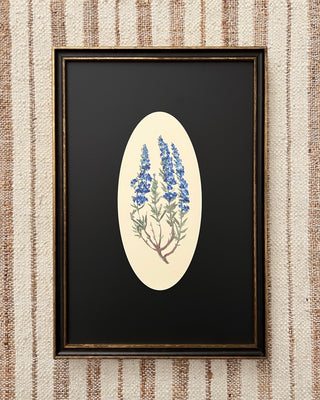Botanicals of the Bible - Hyssop
- Unit price
- /per
“Cleanse me with hyssop, and I will be clean; wash me, and I will be whiter than snow.”
Psalm 51:7
Printed on 100% cotton rag paper with a velvet (or etching like) surface and matte, low-glare finish. This paper is designed for museum quality, limited edition prints.
Unframed paper prints are shipped rolled or in a rigid envelope.
Framed prints are custom-made with care by our team in Mesa, Arizona. Frames are created without an acrylic or glass covering for a high-end, no-glare finish.
Frame Moulding Dimensions:
8x12 (Bronze & Gold) - Frame Width - 7/8", Frame Depth - 1 3/8"
12x18 (Bronze & Gold) - Frame Width - 7/8", Frame Depth - 1 3/8"
16x24 (Bronze & Gold) - Frame Width - 7/8", Frame Depth - 1 3/8"
Orders for unframed prints typically leave our Mesa, Arizona offices within 3-5 days of purchase.
Framed prints are custom made once ordered and are generally shipped within 10-14 days after purchase. Tracking information will be sent via email once your order is on its way.
Returns are available for unframed print orders for a full refund within 30 days of purchase. Because framed prints are made to order, all sales of framed prints are final, and are not eligible for cancellation or exchange.
*For more information about shipping and returns, please see our FAQ page.
Adding product to your cart
-
ABOUT THE ART
Botanicals of the Bible – Hyssop
By Jenny Komenda
“Cleanse me with hyssop, and I will be clean; wash me, and I will be whiter than snow.”
Psalm 51:7
~~~~~~~~~~~~~
In the Bible, hyssop is a small, aromatic plant with delicate branches—yet its role in Scripture is rich with meaning. It first appears powerfully in Exodus 12:22, when, as part of the Passover miracle, God instructed the Israelites to “take a bunch of hyssop, dip it in the blood that is in the basin, and touch the lintel and the two doorposts” of their houses. This simple branch became an instrument of deliverance. Where the lamb’s blood had been applied, death passed over those homes. Hyssop, though fragile, was chosen by God as a tool to apply the symbol of protection and covenant.
Hyssop is used throughout the Old Testament in temple purification rituals, and Moses used hyssop to ritually cleanse the Israelites and ‘seal them in covenant’ after they had received the law. Thus, it became a symbol of cleansing from sin and renewal of the spirit. Remarkably, hyssop appears again at the foot of the cross. The Gospel of John tells us that the sponge soaked in vinegar was lifted to Jesus’s lips “on a stalk of the hyssop plant.” The same plant once used to mark the homes of the faithful with lamb’s blood and bind them in a heavenly covenant was now used as the Lamb of God gave His life for the world as part of the ushering in of a new covenant.
As Neal L. Anderson has taught, “I testify that the Savior is able and eager to forgive our sins. Divine forgiveness is one of the sweetest fruits of the gospel, removing guilt and pain from our hearts and replacing them with joy and peace of conscience.” The hyssop reminds us that God chooses humble things to carry out holy work. Like hyssop, we may feel small or insufficient. Yet, in God’s hand, we can help carry the message of healing and redemption to others. Let this simple plant point us to the greater truth: Christ’s blood still saves. And through Him, we, too, can be saved and made clean.
~~~~~~~~~~~~~
ABOUT THE ART
Botanicals of the Bible – Hyssop
By Jenny Komenda
“Cleanse me with hyssop, and I will be clean; wash me, and I will be whiter than snow.”
Psalm 51:7
~~~~~~~~~~~~~
In the Bible, hyssop is a small, aromatic plant with delicate branches—yet its role in Scripture is rich with meaning. It first appears powerfully in Exodus 12:22, when, as part of the Passover miracle, God instructed the Israelites to “take a bunch of hyssop, dip it in the blood that is in the basin, and touch the lintel and the two doorposts” of their houses. This simple branch became an instrument of deliverance. Where the lamb’s blood had been applied, death passed over those homes. Hyssop, though fragile, was chosen by God as a tool to apply the symbol of protection and covenant.
Hyssop is used throughout the Old Testament in temple purification rituals, and Moses used hyssop to ritually cleanse the Israelites and ‘seal them in covenant’ after they had received the law. Thus, it became a symbol of cleansing from sin and renewal of the spirit. Remarkably, hyssop appears again at the foot of the cross. The Gospel of John tells us that the sponge soaked in vinegar was lifted to Jesus’s lips “on a stalk of the hyssop plant.” The same plant once used to mark the homes of the faithful with lamb’s blood and bind them in a heavenly covenant was now used as the Lamb of God gave His life for the world as part of the ushering in of a new covenant.
As Neal L. Anderson has taught, “I testify that the Savior is able and eager to forgive our sins. Divine forgiveness is one of the sweetest fruits of the gospel, removing guilt and pain from our hearts and replacing them with joy and peace of conscience.” The hyssop reminds us that God chooses humble things to carry out holy work. Like hyssop, we may feel small or insufficient. Yet, in God’s hand, we can help carry the message of healing and redemption to others. Let this simple plant point us to the greater truth: Christ’s blood still saves. And through Him, we, too, can be saved and made clean.
~~~~~~~~~~~~~

you might also like...

OUR WEEKLY PUBLICATION






